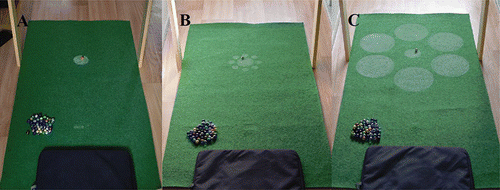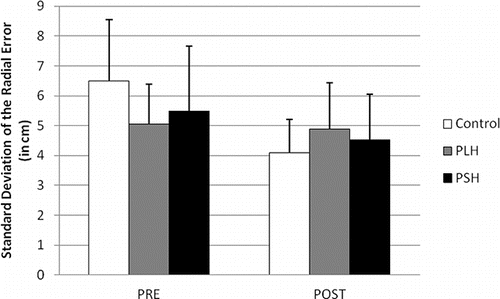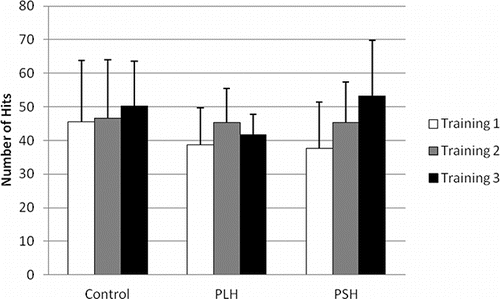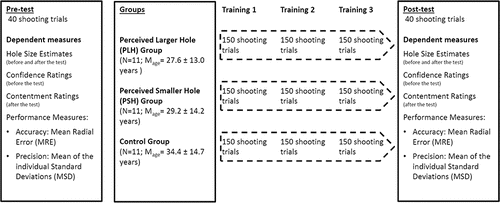ABSTRACT
Recently it has been reported that practicing putting with visual illusions that make the hole appear larger than it actually is leads to longer-lasting performance improvements. Interestingly, from a motor control and learning perspective, it may be possible to actually predict the opposite to occur, as facing a smaller appearing target should enforce performers to be more precise. To test this idea the authors invited participants to practice an aiming task (i.e., a marble-shooting task) with either a visual illusion that made the target appear larger or a visual illusion that made the target appear smaller. They applied a pre–post test design, included a control group training without any illusory effects and increased the amount of practice to 450 trials. In contrast to earlier reports, the results revealed that the group that trained with the visual illusion that made the target look smaller improved performance from pre- to posttest, whereas the group practicing with visual illusions that made the target appear larger did not show any improvements. Notably, also the control group improved from pre- to posttest. The authors conclude that more research is needed to improve our understanding of whether and how visual illusions may be useful training tools for sport skill learning.
Chauvel, Wulf, and Maquestiaux (Citation2015) recently reported that practicing golf putting with visual illusions that make the hole appear larger than it actually is leads to longer-lasting performance improvements. This finding is of major interest to athletes of various sports such as golf, darts, archery who constantly strive to improve their aiming performance. In short, Chauvel et al. invited two groups of nongolfers and asked them to putt golf balls into a target circle. During a practice phase that included five blocks of 10 trials each, either small or large circles inducing the well-known Ebbinghaus illusion were projected around the hole. Size estimates confirmed that the group that putted with smaller circles around the hole perceived the target as being bigger, whereas the group that putted with larger circles around the hole perceived the target as being smaller. Furthermore, the authors found that self-efficacy was higher for those who perceived the target area as being bigger. Participants performed a transfer test without visual illusions one day after the practice phase. Results revealed that putting accuracy (measured as radial errors) was significantly higher in the group that had practiced with the illusion that made the hole appear larger. This finding is in line with previous work showing that putting toward a perceived larger hole can lead to better performance outcomes (i.e., more hits; see Witt, Linkenauger, & Proffitt, Citation2012; Wood, Vine, & Wilson, Citation2013) and it extends this work by showing that even when the illusions are removed after a practice phase the effect may persist.
We argue that from a motor control and learning perspective the findings by Chauvel et al. (Citation2015) are somewhat surprising. That is, from a motor control perspective one may actually predict the opposite to occur. That is, if a target is perceived as being larger (and hence easier to hit) than it is, then performers may actually allow themselves more variance in putting execution as they may predict the ball to still end up in the target area. By contrast, if a target is perceived as being smaller (and hence more difficult to hit) than it is, then performers would need to be more precise and consequently allow themselves less variance in putting execution as they may predict the ball to otherwise miss the target area.
To test our predictions and further examine the effect reported by Chauvel et al. (Citation2015), we invited 33 volunteers (six women, four left-handed; Mage = 30.4 ± 13.9 years) to take part in our experiment (for an illustration of the study design, see ). All participants provided informed consent prior to experimentation, and the study was approved by the ethical committee of the Faculty of Human Movement Sciences, VU University Amsterdam. Participants were tested (pre- and posttest) and trained (three practice days of 150 trials each) on a marble-shooting task (see ). In the pre- and posttest participants kneeled down on a green marble mat (see ) and performed 40 shots with the aim to push the marble (size = 0.16 cm) into the target area at a distance of 53 cm from the marble's starting position. Throughout the experiment participants used their dominant hand. That is, they used the same (dominant) hand in the pre- and posttest and training sessions. The target circle had a diameter of 9.2 cm. Before the pretest, participants first had the opportunity to familiarize themselves with the marble-shooting task in 50 practice trials. For the familiarization trials as well as for all experimental trials the instruction to the participants was to push as many marbles into the target area as possible with the center of target areas as the optimal result. For motivation purposes, before the training sessions 2 and 3 they were additionally instructed to try and perform better than in the previous training session. These instructions were the same for all participants. As concerns feedback or knowledge of performance, with each trial participants could see the result of their attempt, that is, whether the ball ended up in the target circle or not. Additionally, after each test session and training sessions the experimenter informed the participant about the total number of hits during that session.
FIGURE 2. The marble-shooting mats and conditions used in the pre- and posttest (A) and the practice phase by the control group (A), the perceived larger hole group (B) and the perceived smaller hole group (C).

After the practice trials and immediately before the test participants judged the size of the target area by means of a matching task (i.e., they were asked to identify one of nine circles shown on a poster that was identical to the target area's size; circles systematically differed by 0.25 cm). Then they reported their level of confidence on a visual analogue scale (for more information, see below) and performed the 40 test trials of the pretest. After each attempt, one of two experimenters removed the marble from the mat. Participants had 50 marbles at their disposal at the starting position. The outcome of each shot was captured by a camera (Creative Vado; 50 Hz; Creative Labs, Singapore), which was situated at a height of 80 cm right above the target. From the recorded footage, the radial errors measured from the center of the target area to the center of the marble were later derived and analyzed using MS Paint (Microsoft Corporation, Redmond, WA) on a standard computer. After the final test trial, participants once again estimated the size of the target area and rated how content they were with their performance again using a visual analogue scale. The visual analogue scales were presented on a sheet of paper, and scaled from 0 cm (not confident or content at all) to 10 cm (extremely confident or content). Participants were asked verbally how confident or content they were and then marked their decision on the visual analogue scale using a pen. The procedure of the posttest was identical apart from that no familiarization trials were performed.
For the learning phase, we randomly divided participants into three training groups: the perceived larger hole (PLH) training group (see ), the perceived smaller hole (PSH) training group (see ) and a control group training without illusions (see ). As illustrated in , for the PLH group the target area was surrounded by eight small circles with a diameter of 3.5 cm each and for the PSH group the target area was surrounded by six larger circles with a diameter of 20 cm each, respectively. Importantly, before the experiment we ran a pilot study including 54 student participants (none of whom took part in the marble-shooting experiment) to verify that the applied illusion conditions on the green mats indeed showed the predicted illusory Ebbinghaus effects. This pilot study successfully verified the predicted illusion effects. In total, participants completed 450 training trials each, distributed over three training days each including 150 training trials with at least one day of rest between the training days. The duration of the training phase between pre- and posttest did not differ between groups (range = 7.6 ± 2.0 days to 8.5 ± 1.4 days). Further, each training session of 150 trials was split in three blocks of 50 trials with a 1-min break between blocks. Similar to the pre- and posttest, after each attempt the marble was removed from the mat by an experimenter.
To test the effect of training with visual illusions on motor learning, we first ran a 3 Group × 2 Test mixed-design analysis of variance (ANOVA) on the mean radial errors (MRE). This analysis revealed a significant main effect for test, F(1, 30) = 15.085, p = .001, ηp2 = .335, no main effect for group, and most importantly, a significant group by test interaction, F(2, 30) = 4.955, p = .014, ηp2 = .248. As illustrated in , both the PSH group, t(10) = 2.884, p = .016,Footnote1 and the control group, t(10) = 3.512, p = .006, showed a significantly smaller MRE in the post- than in the pretest, indicating that both groups performed more accurately after their training interventions. No such effect was found in the PLH group, t(10) = .085, p = .934.
FIGURE 3. Mean radial errors in cm for the three groups and both testing moments. Bars indicate standard deviations of the mean.

In addition, we ran the same 3 Group × 2 Test mixed-design ANOVA on the mean of the individual standard deviations (MSD) to examine whether any of the interventions, next to improving performance accuracies (as found for the PSH and control groups), also improved performance precision. The ANOVA also revealed a significant main effect for test, F(1, 30) = 14.044, p = .001, ηp2 = .319, no main effect for group, and a significant group by test interaction, F(2, 30) = 4.331, p = .022, ηp2 = .224. As illustrated in , post hoc comparisons (t tests) revealed that both the control group, t(10) = 3.887, p = .003, and the PSH group, t(10) = 1.883, p = .089, showed a smaller outcome variability in the post- than in the pretest, indicating that both groups performed more precisely after their training interventions. No such effect was found in the PLH group, t(10) = .335, p = .744.
FIGURE 4. Mean of the individual standard deviations in cm for the three groups and both testing moments. PLH = perceived larger hole; PSH = perceived smaller hole.

To examine changes in performance during training, we next ran a 3 Group × 3 Training Session mixed-design ANOVA on the number of Hits. Note that we did not use a camera during training sessions, but noted on each trial whether the marble ended up in the target zone (i.e., was a hit), or not. The ANOVA revealed a significant main effect for training session, F(2, 60) = 10.495, p < .001, ηp2 = .259, no main effect for group, and a significant group by training session interaction, F(4, 60) = 3.496, p = .012, ηp2 = .189. As illustrated in , while the PSH group improved significantly over time, F(2, 20) = 10.739, p = .001, ηp2 = .518; the control group, F(2, 20) = 1.733, p = .202, ηp2 = .148; and PLH group did not, F(2, 20) = 2.627, p = .097, ηp2 = .208. Post hoc pairwise comparisons on the significant effect for the PSH group showed that participants in this group hit significantly more often during the second (p = .042) and third (p = .003) training sessions than during the first training session, indicating that training with a perceived smaller hole led to significant performance improvements over time.
FIGURE 5. Mean number of hits per group and training session. Bars indicate standard deviations of the mean. PLH = perceived larger hole; PSH = perceived smaller hole.

Next we conducted two separate 3 Group × 2 Test mixed-design ANOVAs on the mean confidence ratings and the mean contentment ratings (see also A and B, respectively). The ANOVA on the mean confidence ratings revealed a significant main effect for test, F(1, 30) = 8.067, p = .008, ηp2 = .212, as did the ANOVA on the mean contentment ratings, F(1, 30) = 9.372, p = .005, ηp2 = .238, both indicating that participants were more confident to perform well before and more content with how they had performed after the post- than before and after the pretest. No other main effects or interactions were significant.
FIGURE 6. (A) Mean confidence ratings per group and test. (B) Mean contentment ratings per group and test. Bars indicate standard deviations of the mean. PLH = perceived larger hole; PSH = perceived smaller hole.

Finally, two separate 3 Group × 2 Test mixed-design ANOVAs on the mean hole size estimates before the pre- and posttest (see ) as well as after the pre- and posttest (see ) yielded no significant main effects or interactions. This indicates that independent of the training intervention, the training groups did not perceive the hole's size differently when confronted with the test scenario (i.e., the nonmanipulated hole), and hence that changes in performance cannot be attributed to perceptual after-effects.
FIGURE 7. (A) Mean hole size estimates before the pre- and posttest per group. (B) Mean hole size estimates after the pre- and posttest per group. Bars indicate standard deviations of the mean. PLH = perceived larger hole; PSH = perceived smaller hole.

To conclude, we reported data supporting the idea that training an aiming task with visual illusions that make the target look smaller than it is may improve both aiming accuracy and precision, as would be predicted from a motor control and learning perspective. Notably also training without visual illusions showed positive learning effects, whereas training with visual illusions that made the target look larger than it was did not improve aiming performance. The learning effects of the PSH group were not accounted for by differences between groups as concerns confidence prior to performance, contentment after performance, or perceptual after-effects. Rather the PSH group showed continuous improvements in motor performance during training. Obviously, our findings are in conflict with those reported by Chauvel et al. (Citation2015). At least three methodological differences might account for or have contributed to the divergent findings. First, though Chauvel et al. report that a pretest consisting of five putting trials per participant was conducted not revealing any differences between the two visual illusion groups (note that the pretest data is neither reported nor plotted), the authors analyzed both the pre- and the retention test separately (see Chauvel et al., Citation2015). The results for the retention test indicated that the group training with the illusion making the target appear larger scored significantly better than the group that had trained with smaller appearing targets. Yet, importantly, this does not imply a significant interaction between pre- and posttest as this analysis was not run and reported. In contrast to Chauvel et al. we applied a pre–post test design and ran the corresponding 3 Group × 2 Test mixed-design ANOVAs allowing us to analyze the interaction between intervention (group) by test (pre vs. post). Given that we ran such a full mixed-design analysis, our results may actually be more critical to the assessment of the research question. Second, also in contrast to Chauvel et al. we included a control group that trained without visual illusions, which – as highlighted by our results—is crucial to assess the additional value of training with illusions. Third, Chauvel et al. had participants put a total of 50 trials (five blocks of 10 trials each) during the practice phase. We increased the amount of practice to 450 trials across three trainings sessions and various days, and also our pre- and posttest included 40 trials each (instead of five and 10 trials, respectively, in Chauvel et al., Citation2015). Taken together, we feel that these methodological differences between Chauvel et al. and our study can only be interpreted in favor of the credibility of our findings.
Following this line of reasoning, publishing our data seems of utmost importance to us for at least two reasons: First, the original findings are likely to be received with great interest by athletes and coaches as they seem to indicate that training golf putting (and perhaps aiming tasks in more general) with targets that appear larger than they are by means of visual illusions may improve aiming performance during competition. Second, our findings challenge the idea that self-efficacy or confidence boost aiming performance when training with targets that appear larger than they actually are (Chauvel et al., Citation2015; Witt et al., Citation2012). Our findings did not show any differences between groups (and hence illusions) as concerns confidence prior to performance and contentment after performance, thereby stimulating further research that may hopefully increase our understanding of the potential causes underlying the effects of training with visual illusions on motor skill learning.
However, given that at the same time we also found that visual illusions may influence aiming performance (see also Cañal-Bruland, Voorwald, Wielaard, & van der Kamp, Citation2013), we call for more research examining the impact of visual illusions on aiming tasks that also further our theoretical understanding of the underlying mechanisms mediating such effects. This is an important endeavor to be able provide evidence-based, practical recommendations as to whether visual illusions can be used to facilitate motor skill learning in sports and other domains.
Note
Notes
1. To account for multiple post hoc comparisons the α level of .05 can be adjusted by dividing it by the number of comparisons run (Bonferroni correction). In this particular case, the adjusted p value is .0167. Note that for all statistics we report the original (noncorrected) p values.
References
- Cañal-Bruland, R., Voorwald, F., Wielaard, K., & van der Kamp, J. (2013). Dissociations between vision for perception and vision for action depend on the relative availability of egocentric and allocentric information. Attention, Perception, & Psychophysics, 75, 1206–1214.
- Chauvel, G., Wulf, G., & Maquestiaux, F. (2015). Visual illusions can facilitate sport skill learning. Psychonomic Bulletin & Review, 22, 717–721.
- Witt, J. K., Linkenauger, S. A., & Proffitt, D. R. (2012). Get me out of this slump! Visual illusions improve sports performance. Psychological Science, 23, 397–399.
- Wood, G., Vine, S. J., & Wilson, M. R. (2013). The impact of visual illusions on perception, action planning, and motor performance. Attention, Perception & Psychophysics, 75, 830–834.

